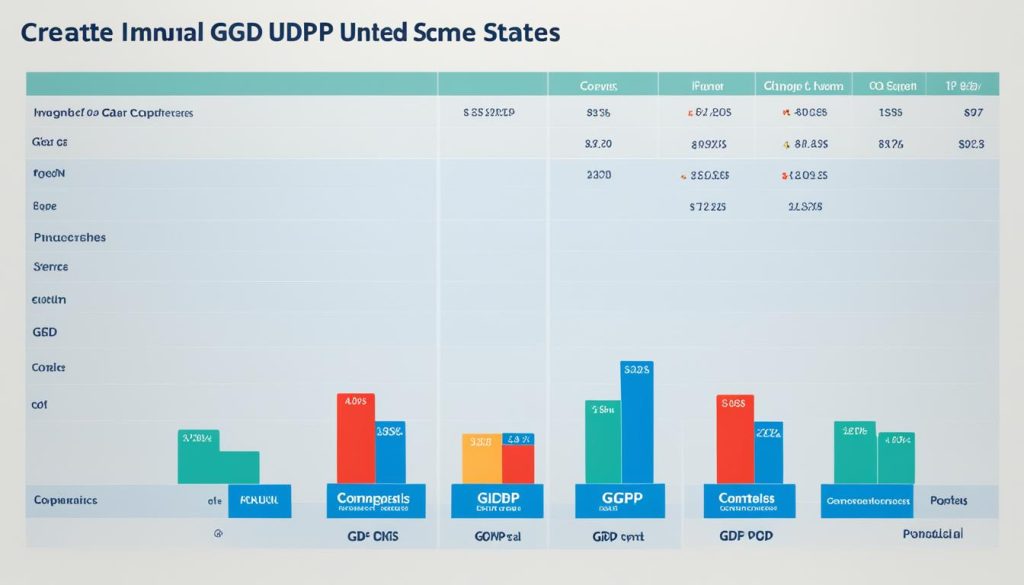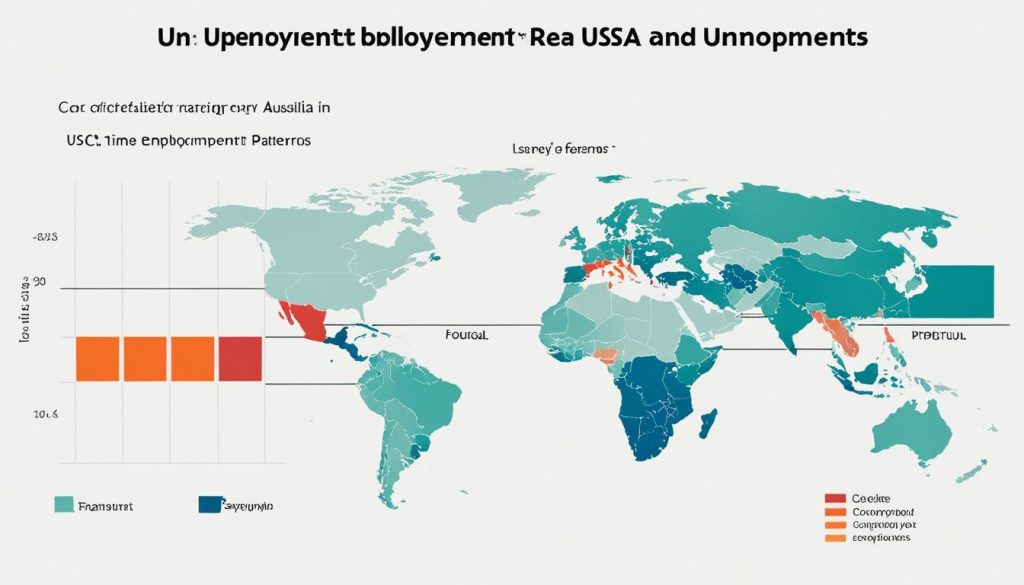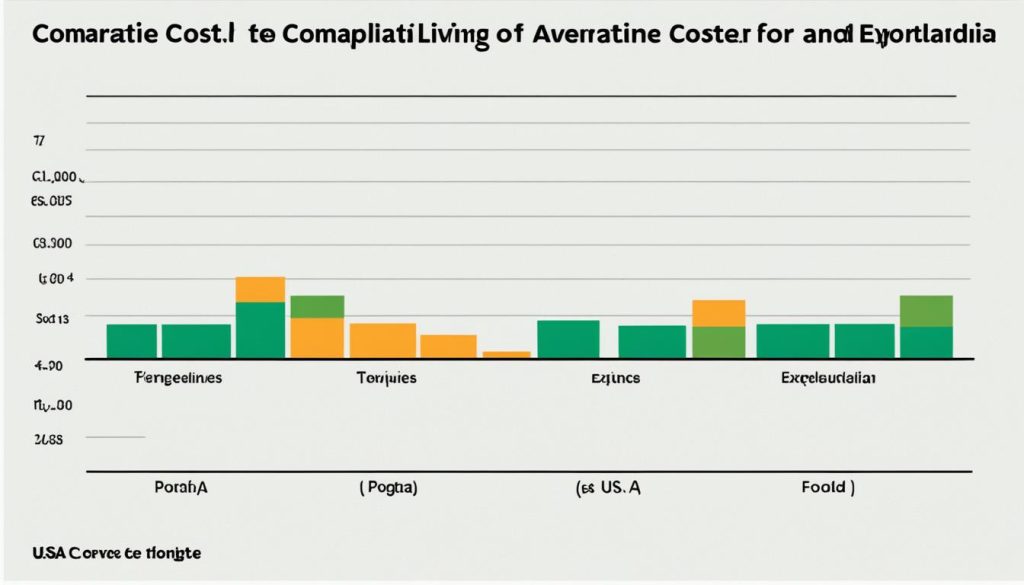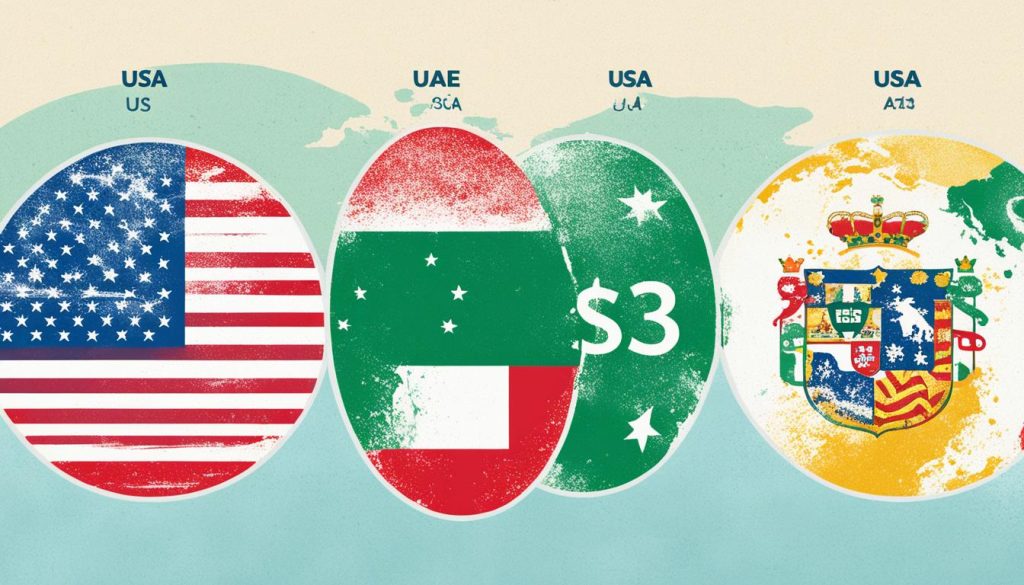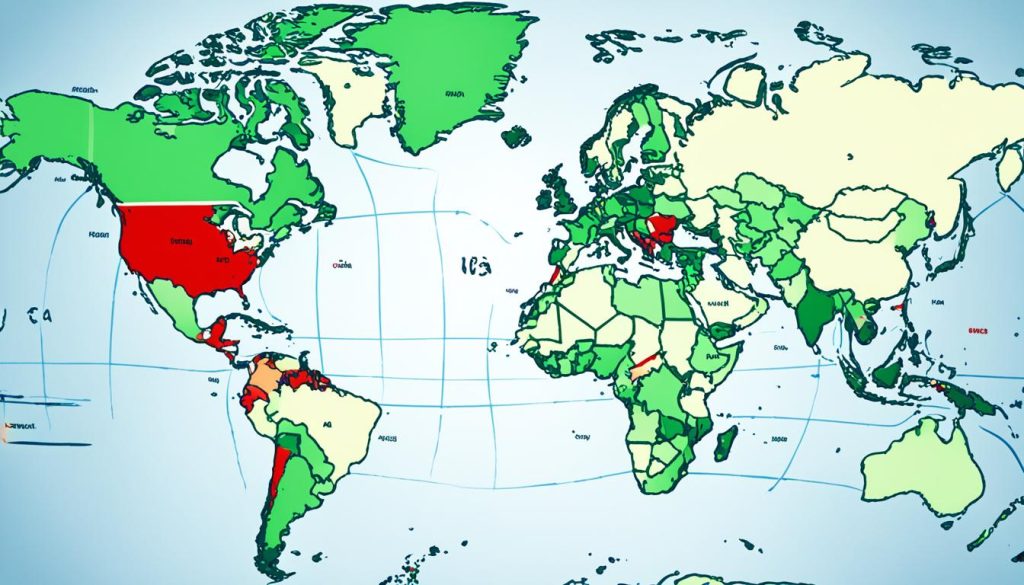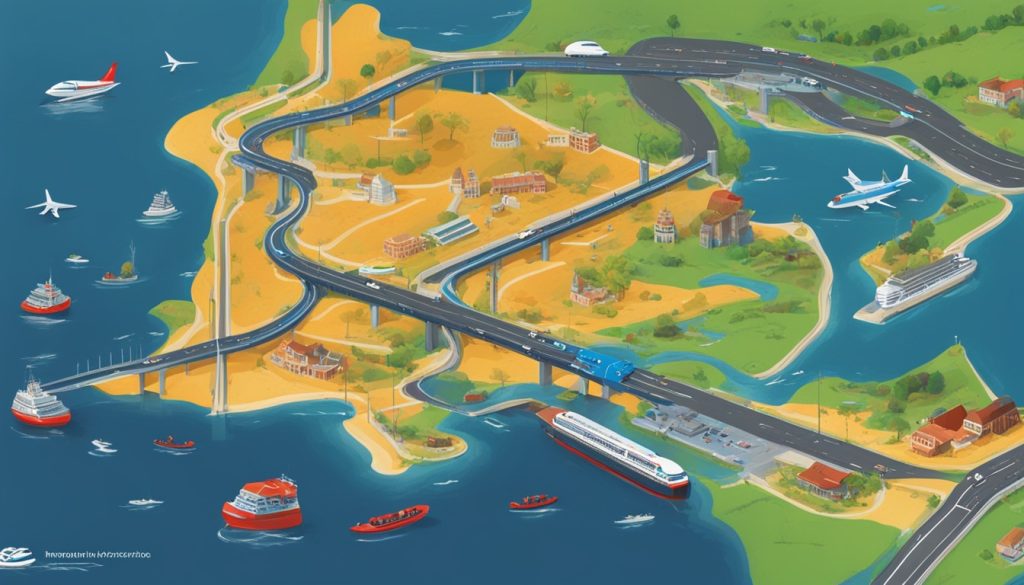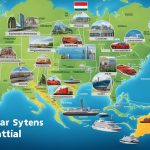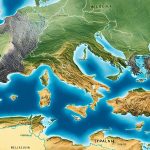Today, comparing the economy, lifestyle, and living standards is crucial for both people and decision-makers. By looking at different countries like the United States, Australia, and Portugal, we can learn a lot. These nations offer a unique mix of economic strength and cultural traits.
To understand the quality of life in these countries, we must consider several factors. Economic stability, access to services, and the environment are key. This sets us up to dive deeper into the living standards of the United States, Australia, and Portugal.
Introduction to Cross-Continental Living Standards
We look at how the USA, Australia, and Portugal take care of their people’s well-being. This journey shows us different ways of life and economic health. It uses various measures of life quality.
In each country, different cultures, societies, and politics mean people live in unique ways. We compare these aspects to show real-life conditions. Our focus also includes economic resources and services that help people live better.
- Economic opportunities and their accessibility for the average citizen.
- The scope and efficiency of social services provided by the government.
- The overarching quality of life as reflected by various national indices.
This analysis helps us understand the differences. The USA has a strong economy, while Australia competes closely. Portugal’s economy is growing too. But living well is not just about money. Social and cultural experiences also matter a lot.
Let’s see what life is like across these continents. From the lively US cities and Australia’s coasts to Portugal’s historic sites, it’s a fascinating study.
Demographic Dynamics and Population Insights
Looking into how populations change is key to understanding life quality in countries. By studying demographics, we learn about a country’s capacity to support its people. This includes looking at the challenges brought by age diversity and population numbers. Migration highlights shifts in society and economic strength, reflecting the opportunities within a country.
The Impacts of Population on Quality of Life
How a nation’s population size and age affect life quality is complex. As people’s needs change, governments must adjust services like healthcare and jobs. Recognising and meeting the varied demands of different population groups is critical.
Comparing Average Age and Population Density
The age and location spread of people in a country tell us about its lifestyle and services. Demographic studies show the big differences in how countries like the USA, Australia, and Portugal manage their people. Australia has a low density of 3.4 people per km², unlike Portugal’s 112.9 people per km². This affects how each country approaches population control and urban living.
Migration Trends Across the USA, Australia, and Portugal
Migration shapes the social structure of countries. The USA sees continuous change with its long history of welcoming people from abroad. Australia changes its policies to adapt to new migrants. Portugal sees ups and downs in migration that impact jobs and population figures. These trends highlight the importance of keeping an eye on migration.
In summary, every place has its unique story of age, population density, and migration. These factors are vital in making policies that improve everyone’s life quality.
Economic Engines: A Comparison of GDP and National Income
GDP and national income tell us a lot about a country’s wealth and economic health. By looking at these numbers, we can see how fast an economy is growing. We can also learn how countries like the USA, Australia, and Portugal use their resources to help their people and economies.
The USA has a strong and varied economy, often used as a standard for GDP comparisons. When we look at Australia and Portugal, we see the size and effect of their economies. Australia stands out globally, with its GDP reaching 1,692,957 million USD.
Australia’s GNP, at 1,582,214 million USD, shows its wealth and growth potential. This figure is more than just a number. It shows Australia’s strength in building wealth and continuous growth.
Portugal, on the other hand, has a GDP of 255,197 million USD and a GNP of 270,087 million USD. Although smaller, these numbers show Portugal’s drive to improve its economy. Both countries play active roles in the world economy, showing their unique strengths.
- GDP of Australia vs Portugal: Reflecting comparative economic scales and output.
- GNP of Australia vs Portugal: A closer look at national income.
- The broader implications on financial well-being for citizens and policy-making.
In summary, though the US economy is very powerful, comparing the GDP and national income of Australia and Portugal helps us understand their economic size and strategies. It shows how they aim for sustainable growth and the well-being of their citizens.
Analyzing Unemployment Rates and Job Markets
Exploring unemployment trends and job market conditions sheds light on a country’s economic health. Changes in employment rates significantly affect views on economic stability. A thorough workforce analysis helps us understand different regions’ socio-economic settings.
Australia and Portugal provide an interesting comparison of their job markets. Their employment data show how jobs relate to economic strength.
Country-specific Challenges and Opportunities in Employment
In Australia, unemployment is low at 3.7%. This indicates a strong economy that’s creating jobs. However, it might lead to a shortage of skilled workers.
Portugal, with a 5.8% unemployment rate, faces different issues. Higher unemployment suggests economic challenges but also chances for growth. Improvements depend on strategic investments in people.
The Role of Unemployment in Economic Stability
Unemployment rates deeply impact economic stability. They’re key for gauging a nation’s financial health. Low unemployment, like in Australia, boosts consumer confidence and business growth.
High unemployment in places like Portugal demands government action. This can include stimulating the economy or improving workforce skills. These responses reflect a nation’s effort to balance its job market.
Cost of Living: A Crucial Quality of Life Metric
Comparing the cost of living gives us a clear picture of how money is managed in different countries. In Australia, it costs more to live than in many places. But, Portugal is more pocket-friendly, according to their price index.
Understanding how the cost of living differs is key when thinking about moving or investing overseas. This includes everything from food and housing to transport, education, and healthcare. Next, we’ll look at how Australia and Portugal compare in these areas.
- Rent and Housing: Homes matter a lot in cost of living. Australian cities often cost more than places in Portugal.
- Groceries and Food: The price of everyday food items varies, with Australia usually being pricier.
- Utilities: Bills for electricity, water, and gas affect living costs. They show how well each country manages its finances.
- Transport: Looking at transport, there’s a clear difference in costs. This impacts how much we spend overall.
- Entertainment and Leisure: Fun and games also play a part. Luxuries tend to cost more in Australia.
So, people must think carefully about these costs. They greatly affect what kind of life you can have in these countries. With Australia’s costs being higher than Portugal’s, managing your money wisely is crucial for a good lifestyle.
Remember, these numbers give a general idea. But everyone’s situation is different. Always make a personal cost comparison before making big moves or decisions.
Decoding the Quality of Life Index
The quality of life index is a key tool in assessing how well a country supports its people’s needs and happiness. It highlights important areas that show a nation’s quality of living standards. There is a big difference in life satisfaction across countries, shown by detailed well-being metrics. Let’s take a closer look at how Australia and Portugal rank in different aspects of life quality.
- Political Stability: This shows how well a country is governed. Australia gets a high score of 89, meaning it has strong leadership. Portugal scores 75, indicating fairly stable politics, but not as strong as Australia’s.
- Civil Rights: This is about the rights and freedoms people have. With a score of 94, Australia shows great respect for personal freedoms. Portugal scores 76, showing it respects rights but not as much as Australia.
- Healthcare Provisions: Healthcare is crucial in evaluating life quality. Both countries do well here but could do better.
- Environmental Climate: A good climate boosts well-being. The unique geography of each country affects their climate scores.
- Cost of Living: This measures how expensive it is to live in a country. Australia’s cost is high, showing its developed economy. Portugal is more affordable.
Looking at the quality of life index, we see more than numbers. These numbers tell us about everyday life, public feelings, and hopes for the future. Detailed metrics like these help us understand and compare the real essence of life satisfaction and quality of living standards in different places.
Healthcare Services: Availability and Quality Assessments
Healthcare infrastructure is vital for a nation’s overall quality of life. Key factors like access to healthcare, the availability of doctors, and hospital services impact public health. Life expectancy helps us judge a healthcare system’s success. We will look at the healthcare systems in Australia and Portugal and their impact on citizen wellbeing.
Hospital Bed and Physician Ratios in Comparative Perspective
Looking at healthcare quality involves examining hospital bed and doctor ratios. In Australia, there are 3.84 hospital beds and 4.10 doctors for every 1,000 people. This shows a strong capability to provide hospital care. Portugal has 3.45 hospital beds but a higher doctor rate of 5.62 per 1,000 people. This highlights both countries’ dedication to healthcare and their health policy priorities.
The Significance of Life Expectancy as a Health Indicator
Life expectancy is a key measure of how well a healthcare system is doing. It reflects the quality of medical care, access to health services, and health initiatives. Australia sees a life expectancy of 81 years for men and 85 for women. This is thanks to its healthcare, active living, and high standards. Portugal’s life expectancy is 78 for men and 84 for women, pointing at differences likely affected by diet, healthcare access, and health strategies.
Our review shows that health outcomes depend on many complex factors. This includes each country’s approach to healthcare quality and service delivery. Thus, evaluating healthcare systems must look at the wider cultural, economic, and environmental background.
Compare Economy and Quality of Living Between USA, Australia and Portugal
When we compare living standards, we look at what makes life good. This includes visible and invisible things that contribute to happiness and success. We examine life in the USA, Australia, and Portugal by looking at their economies, how people live, and overall happiness.
Each country has its own special qualities and economic conditions. Our comparison shows how different aspects of life determine how people live around the world. These differences tell us about financial stability, access to basic needs, and chances to have fun.
- Lifestyle Quality: Assessing the holistic nature of day-to-day experiences, including access to cultural amenities and work-life balance.
- Economic Performance: Examining GDP, employment rates, and fiscal health as benchmarks for financial vitality and prospects for growth.
- Cross-Continental Analysis: Contrasting the aforementioned metrics to draw parallels as well as highlight disparities amongst continents.
- International Living Conditions: Considering healthcare, infrastructure, and environmental indices amongst the key contributors to a quality lifestyle.
We don’t just look at numbers. We also see how these numbers affect people’s happiness and national spirit. Looking at the USA, Australia, and Portugal, we see how the economy shapes real-life experiences. This includes jobs and how we connect with others.
Our study shows that money matters, but life’s quality is about more than just finances. It’s also about the unique experiences of each country.
Residential and National Infrastructure
As countries grow, the importance of infrastructure development can’t be overstated. It’s crucial for improving how people live. In Australia and Portugal, we see this in action. They both manage their residential and national transportation in unique ways.
Transport Networks and Accessibility
In Australia, vast road networks bring together cities and remote places. This effort shows Australia’s goal to boost infrastructural efficiency. Portugal, on the other hand, focuses on bettering its transport systems’ quality. This makes getting around within its smaller area easier.
- Roadway extension and maintenance
- Public transport connectivity
- Railway and waterway infrastructure advancements
Energy Production and Consumption Patterns
Looking at energy management and usage tells a lot about a country’s sustainable effort. Australia uses its vast natural resources to meet its high energy needs. This supports distribution across the country. Portugal, while producing less energy, aims for renewable sources and smarter use.
- Assessment of energy production metrics
- Renewable energy utilisation
- Energy efficiency measures
Australia and Portugal both seek a balance in expanding and caring for their infrastructure. They recognize the need to grow sustainably.
Education and Literacy: Key Factors in Quality of Life
Exploring education’s role shows it’s the cornerstone of better societies. Countries like the USA, Australia, and Portugal invest in education to boost economic and social growth. By focusing on academic opportunities, they secure a bright future for their citizens.
To improve literacy rates, these nations enhance schooling and the overall intellectual development of individuals. This approach highlights the link between education quality and life satisfaction. Countries with top educational outcomes enjoy stronger economies and societies.
- Educational Standards: High-quality education policies reflect a commitment to building informed societies ready for future challenges.
- Schooling Quality: Quality education relies on great infrastructure, qualified teachers, and a variety of learning materials.
- Academic Opportunities: The range of educational paths shows a nation’s dedication to diverse career options for students.
- Literacy Rates: Being able to read and write is essential. High literacy indicates wide access to basic education.
- Intellectual Development: Developing skills like critical thinking and problem-solving early on is crucial for creating versatile individuals.
The differences in education policies between the USA, Australia, and Portugal provide valuable lessons. These variations show the diversity of global education systems. They offer ideas for improving educational frameworks everywhere.
Climatic Conditions and Environmental Impact
When we look at how liveable different places are, we consider the climate, weather, and how green they are. These elements greatly affect our surroundings and how happy people feel living there. We will look at how Australia and Portugal provide good climates for people. We’ll also see what they’re doing to keep their countries green.
Climate as a Contributing Factor to Livability
Australia and Portugal have very different climates. Australia is usually hotter, with temperatures around 24.3°C and less humidity. This means Australians live differently to cope with their weather. On the other hand, Portugal has cooler days, around 21.6°C, and it’s more humid. These weather conditions offer residents different lifestyles. Comparing climates helps people decide where they’d prefer to live.
Environmental Policies and Their Influence on Living Standards
- Good environmental policies help improve sustainability and life quality.
- In Australia, the focus is on cutting carbon footprints and protecting nature.
- Portugal is working on boosting green energy and using more renewables, showing its commitment to being eco-friendly.
- Such policies are key to protecting nature and making sure people have a great place to live and work. The effort to enforce these policies keeps our living spaces appealing.
These policies show a commitment to keeping the balance between nature and our built world. They aim to protect our communities’ well-being and future. As the climate changes and we aim for better places to live, having smart climate policies is key. These policies are crucial for everyone’s life.
The Legal Landscape: Civil Rights and Governance
The strength of a society is seen in its governance quality and how well it protects civil rights. A strong legal system boosts rule of law and supports democratic participation. Australia shows this with its high rank against global corruption, meaning it’s seen as having little corruption and excellent regulation. On the other hand, Portugal, despite its average rank, is improving its protection of freedoms, showing a governance system that’s getting stronger.
- Rule of law shows quality governance and builds trust in society
- Civil rights protection shows how effective a legal system is
- Democratic participation is key to a strong legal structure
Australia is known for its dedication to civil rights and democracy. This is because of its history of legal changes meant to make people trust the government more. Portugal is also doing well in protecting civil rights. But, it shows that to reach global standards, it needs to keep getting better at governance.
- Great law enforcement keeps society united and trusted
- Forward-thinking in protecting freedoms and rights
- Open political processes make democracy stronger
In conclusion, as both countries work on their legal rules, differences in openness and how much the public is involved show their efforts towards top-notch governance. Striving for a future where everyone’s freedoms are protected is crucial. It’s these ongoing improvements that show a country’s commitment to democratic values.
Cultural Diversity and Language Use Patterns
Cultural integration and societal multiculturalism play a key role across the globe. Linguistic diversity within countries helps strengthen social ties. It enhances our understanding of how communication, culture, and community are linked.
The Influence of Language on Social Integration
Being fluent in a language is crucial for blending cultures, leading to better mutual understanding. In places like Australia and the USA, it bridges social divides. This allows different cultures to mix and grow.
It’s important for public services, schools, and businesses to support various languages. This approach furthers inclusivity and unity in communities.
Cultural Diversity in Australian, American, and Portuguese Society
In Australia, the mix of languages spoken, such as Chinese and Italian, showcases its multicultural approach. This leads to more cultural exchanges and awareness. In contrast, Portugal mainly speaks Portuguese. This provides a sense of unity but still leaves room for cultural diversity.
- English as a language of unity amidst Australia’s diverse multilingual communities.
- The influence of primary language use on societal inclusion in Portugal.
- The intricate balance between maintaining linguistic heritage and embracing new languages for both personal growth and social cohesion.
Evaluating Political and Economic Stability
The strength of a country’s growth depends on political stability and economic consistency. These elements are vital for financial security and clear governance. They build trust among the people. Looking at Australia and Portugal shows us that these factors vary. They reflect how well a government functions and the values of its society.
Political Transparency and Its Effects on Livelihood
Political steadiness relies greatly on how transparent a government is. Australia is known for its clear policies and stable government. This provides a good quality of life for its citizens. Meanwhile, Portugal, which has moderate transparency, faces challenges to ensure its citizens’ well-being.
Economic Predictability and Security
Economic stability is crucial for a nation’s growth. Australia shows this through its low debt and strong economy. This helps businesses and families alike. But Portugal, with its higher debt, needs to work on financial stability. This is important for the trust of investors and the country’s future. These examples show how countries manage their economies in different ways.
- Political stability serving as the cornerstone for societal trust and engagement
- Transparency in governance and its role in maintaining ethical and accountable leadership
- Economic consistency as a driver for sustained growth and prosperity
- Financial security’s impact on individuals’ capacity to plan for the future
- Governmental effectiveness in policy formulation and crisis response
Assessing Telecommunication and Internet Access
In today’s world, telecommunication access and internet connectivity are crucial. They help countries like Australia and Portugal grow economically and socially. Digital infrastructure and online engagement are key. They combine with mobile and fixed line services to show how tech supports our daily lives.
Internet Penetration and its Role in Contemporary Living
As digital needs grow, having internet access is key to progress. In Australia, the rise in digital skills and internet usage shows people’s keenness to join the digital world. This boosts the economy and life quality. Portugal sees the internet as a force for change, used in education, business, and chatting online. Both countries show how vital internet access is today.
Comparing Landline and Mobile Cell Infrastructure
Looking at telecom, we see old tech like landlines and new mobile networks. Australia loves mobiles, shown by many mobile subscriptions. Portugal’s use of mobiles is growing too, showing its adaptability in telecom evolution. This growth shows a promise to keep everyone connected smoothly.
- Exploration of telecommunication’s impact on socio-economic factors.
- Insights into the integration of cutting-edge technology in telecom.
- Analysis of national efforts to enhance internet accessibility.
Conclusion: Weighing Up Global Living Standards
Looking into global living standards means more than just numbers. We need to think about social lives and everyday realities too. This makes comparing life quality worldwide quite complex. Each country, like the United States, Australia, and Portugal, has its own strengths and challenges.
In Australia, the incredible variety of life and strong economy face environmental and infrastructure issues. Portugal offers a rich life through its culture and lifestyle, despite economic challenges. The USA shows the diversity of living standards across its regions, highlighting its economic strength.
This study offers a detailed look at what makes countries unique in terms of living. It ties together healthcare, education, and more, showing how these factors create different living conditions. It helps people choose where to live while understanding global life quality better. Recognising each country’s unique story helps us see the complex nature of global living standards.



